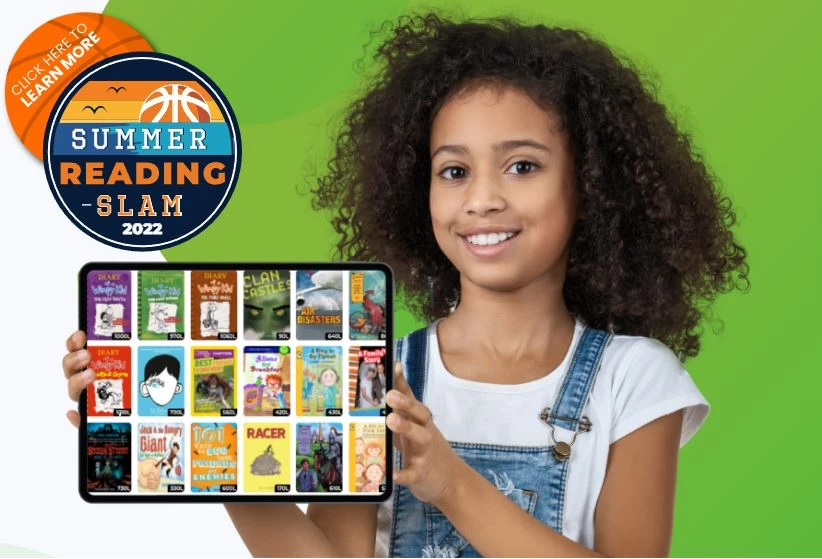
 Christian Reed is a 5th grade teacher at Figueroa Street Elementary in Los Angeles, California. He started piloting LightSail back in 2015 for use during the independent reading period. Over the course of the 2016-2017 school year, Reed’s class read for over 55,000 minutes and completed over 1,000 books. These students grew, on average, over 120L, outpacing MetaMetrics’ benchmark* growth for 5th grade.
Christian Reed is a 5th grade teacher at Figueroa Street Elementary in Los Angeles, California. He started piloting LightSail back in 2015 for use during the independent reading period. Over the course of the 2016-2017 school year, Reed’s class read for over 55,000 minutes and completed over 1,000 books. These students grew, on average, over 120L, outpacing MetaMetrics’ benchmark* growth for 5th grade.One of the first things that 5th grade teacher Christian Reed appreciated about LightSail was its ability to provide engaging books at the Lexile measure of every one of his students — regardless of whether or not they were reading on grade level. Not only did this impact the class’s independent reading time but it allowed Reed to work with small groups, knowing that the rest of the students had something they could truly read on their own. As a veteran teacher, he had always done his reading differentiation without the help of technology. With LightSail, though, he could have his students’ various needs met, even when he was not directly working with them.
Some of Reed’s favorite features in LightSail have to do with accountability, including notifications about student assessment performance, alerts about reading speed, and the ability to see which books they complete or abandon, within their portfolios. “It’s great,” Reed said, “to have concrete ways of knowing when and how they ‘veered off the path’ during reading.”
“Immediate feedback has always been a priority for me as a teacher and LightSail lightened that load of collecting data,” Reed explained. “Plus it gives me tools for conversations about their reading behaviors, especially if I show them tangible evidence that, for example, they’ve been blowing through pages without comprehending.”
Reed had always done reading conferences but since LightSail’s collection of student reading data “lightened his load,” he was able to do it more regularly – and more meaningfully. His students loved the focused attention and personal feedback that he was able to give them about their reading through the application.
“I’ve been a teacher for 15 years, so it was great that LightSail integrated into many areas of my existing practice – but it also helped me to look at data in a new way and to reflect on areas I need to concentrate on for individual students,” said Reed.
As a seasoned educator, Reed knew that if his class was going to stick with LightSail, it needed to be implemented with fidelity. At the very start, he made a minimum requirement of his students to read for 30 minutes per day during their 50 minute guided reading period.
“If students are only reading 10 minutes per day, you’re not going to see positive gains,” says Reed. “Even with 20 minutes, you’re only going to see some progress in some students. Since many don’t read at home, this 30 minutes of in-school reading is very important for my students. As a teacher, you set that tone –you keep that time sacred and help your students to build good habits.”
“Having a significant chunk of time to read during the day helps kids to be able to get into a book and keep up with what they’re reading,” Reed explained. As a result, he saw a lot less book abandonment because kids were invested and had books they wanted to return to the next day. And, as they logged more reading time, students began to notice their own growth and began self-monitoring their Lexile levels.
“If a student’s Lexile goes up in my class, I don’t have to point it out to them, they’ll let me know!” said Reed. “They’ll call me over and show me what was going on, celebrating themselves for their accomplishments — and, of course, I celebrate with them.”
Reed believes that the ability for kids to see their own growth underscores the value of independent reading time and helps them to take ownership and gage whether or not they’re making progress. He helps them along by displaying achievement on bulletin boards, showing their Lexile growth over time.
“The way LightSail makes growth visible is so motivating for kids,” he said. “LightSail as a tool is my best shot for the ones who usually don’t read very much. I don’t get any resistance when it comes to reading on LightSail, no ‘this is boring’ or ‘there’s nothing I like’. Instead it’s like, they get to read today, and they get to read what they want based on their level. They’re excited!”
At the beginning of each school year, Reed talks to his new 5th graders about choice and responsibility. He says LightSail has helped him promote positive behaviors in these areas.
“I tell them that in 5th grade they’re going to start making decisions and choices without me micromanaging,” he says. “LightSail really gives them a choice. That’s powerful and motivating for kids.”
Reed isn’t just excited about what LightSail is doing for his kids. He says it enhances his daily practice, making him more data-savvy and more reflective. He’s looking forward to expanding his use of LightSail to do guided reading and whole-class novels. Looking to the future, he explains: “At times when you start using something new in the classroom, it can feel overwhelming. But when it’s the right tool, it’s very, very exciting.”
*Typical MetaMetrics growth is based on ‘Williamson, G. L. (2015) Novel interpretations of academic growth’ from MetaMetrics.
Posted on 8.Aug.17 in Partner Success




